Research Article
IMPACT OF RURAL TOURISM ON LOCAL COMMUNITY LIVING
4884
Views & Citations3884
Likes & Shares
Rural tourism activities are actively and increasingly pursued. Organizing various programs and activities of interest in rural tourism activities has sparked a great phenomenon in the outside community. However, this activity has a considerable impact on various communities, whether negative or positive. The purpose of this paper was to identify the extent to which this impact exists in a rural tourism area in the district of Kuala Selangor, Malaysia. The theoretical framework has generated four main components of impact and 26 sub-components. A total of 200 respondents were interviewed. The results found that 20 elements are statistically significant. It also highlights the correlation between these elements and demographic profile. Overall, the cultural impact is more significant than the other impact such as economic, social and environmental. Impact of rural tourism on local community living.
Keywords: Rural Tourism, Community Development, Cultural, Economic, Social, Environment
INTRODUCTION
Rural tourism exists in various terms namely farm tourism, agro tourism, soft tourism or ecotourism (Beeton, 2006) which normally concentrates on suburban and rural areas (Bramwell, 1994) that are surrounded by agricultural land. Rural tourism activities become one of the government agendas in an effort to boost the development of rural areas and the living standards of local communities (Fariborz & Gill, 2009; Canoves et al., 2004). Through these activities, rural tourism is growing from time to time which provides the best opportunity for the rural area (Ridzuan et. al. 2018; Jaafar et al, 2015; Ap & Crompton, 1998; Lo et. al., 2012) to be famous place among the communities (Roddin et al, 2019).
However, the continuity of these activities from time to time has indirectly impacted community development (Daniela, 2002; Jashveer et. al., 2011). However, this kind of activities has contributed positive and negative impact on local community living (Lo et. al, 2012; Seetanah, 2011; Kamil & Abdoellah, 2018). Therefore, this research was conducted to identify to what extent these rural tourism activities contribute to the development of the local community. Four main dimensions have been studied, namely Economic, Social, Cultural and Environmental.
LITERATURE REVIEW
Generally, when a place has been declared as a tourism area, it either has its own history or the area is purposely developed with various facilities and amenities with the main aim to provide attractions and create the readiness of tourists to visit. In fact, various commercial buildings have been developed as tourism area in providing a space for local people to be involved in business activities. Therefore, rural areas that are surrounded by a green environment, now vigorously developed with various types of development to meet tourism activities (Zhang & Walsh, 2021).
Therefore, current activities from rural tourism can be seen through the significant changes in the economic situation of the local community (Teng et. al., 2018; Amalu et al, 2012; Kim, 2002; Kreag, 2001; Mirbabayev, et. al., 2011; Samina, 2007; Jaafar et al, 2015). In fact, the local people also have an opportunity to increase their income through the sale of various local goods (Stynes, 1997; Jipun, 2019), which are usually in high demand from foreign tourists. Among them are unique and interesting handicrafts. A lucrative income certainly has a positive impact on the local community’s life (Kreag, 2001; United Nation, 2005; Sanggin, 2009; Weaver & Lawton, 2001).
Rural tourism also exposes locals to social change (Jaafar et al, 2015; Kim, 2002; Shagazatova et al, 2011 in Wend 2013). Tourist areas involving attractive recreational areas have been showered with various elements of development (Zhang & Walsh, 2021; Jaafar et al, 2015). Recreational areas continue to be worked on with the improvement of various infrastructure facilities (Amornwitthawat & Tanakanjana Phongkhieo, 2019), such as health facilities, water supply, shopping malls, sewerage, streetlights, public toilets and parking lots.
The recognition of the local area as a tourist centre to some extent contributes to the popularity status of its residents and creates a sense of pride among its residents. Besides that, various interesting cultural activities which are being introduced become one of the tourism attractions among the tourist (Jaafar et al, 2015). The environmental attribute can also be seen through the level of land use for the tourism agenda (Yang et al., 2021). These tourist areas are mostly decorated with interesting landscape.
However, tourism activities in rural areas also contribute negatively to community development (Kreag, 2001). More exploration activities on the environment have invited ecological change as well as changing the chain of environmental life (Creaco & Querini, 2003). The presence of a large number of tourists also contributes to the high rate of crowd and congestion.
Besides that, the existence of entertainment centres that were originally intended to provide tourist attractions (Cheng et al., 2013) indirectly exposes the locals to undignified activities. Most young people, who are still looking for an identity, can be seen to follow the culture of foreigners (Esfandiar et al, 2021) who come to visit, especially from the way they dress and their daily activities.
There is also a negative relationship between rural tourism and the economic situation where many workers, especially construction workers who will lose their jobs after the construction of tourist buildings are completed (Kim, 2002). Apart from that, the price of daily necessities also increased, especially on local food (Ertuna & Kurbas, 2012) due to the increase of lifestyle and land value in the tourism area. Due to the increase in the unemployment rate, the community also face various criminal cases. Therefore, rural areas that were once peaceful now need close monitoring by the authorities to address the crime problem.
There is also a negative relationship between rural tourism and the economic situation where many workers, especially construction workers who will lose their jobs after the construction of tourist buildings are completed (Kim, 2002). Apart from that, the price of daily necessities also increased, especially on local food (Ertuna & Kurbas, 2012) due to the increase of lifestyle and land value in the tourism area. Due to the increase in the unemployment rate, the community also face various criminal cases. Therefore, rural areas that were once peaceful now need close monitoring by the authorities to address the crime problem.
Pollution problems also occur in tourism areas. High consumption of transportation services also contributes to the air pollution problem (Alves et al., 2021; Liu & Lu, 2021). High flight rates and water sports using the boat services and surfers may contribute to the pollution in the current environment (Li & Zhang, 2020). While the facilities maintenance and waste from hotels operation have become one of the contributors to the pollution problem (Mugilarasan et al., 2021; Esfandiar et al, 2021). However, conservation efforts are still being made by the government to ensure sustainable living. Tourism activities have shown four main effects on two different sides either positive and negative side. Thus, this study looks at the extent to which these rural tourism activities affect the local community.
RESEARCH METHODOLOGY
Research has been done at the District of Kuala Selangor Malaysia, as one of the rural tourism areas in Malaysia. It covers an area of 1,194.55 square kilometres with nine sub-districts namely Kuala Selangor, Jeram, Ijok, Tanjung Karang, Api-api, Ujong Permatang, Ulu Tinggi, Bestari Jaya and Pasangan. 200 respondents have answered the survey, who are local people staying in this rural tourism area.
Four main components of tourism impact were expanded to 26 related elements in the questionnaire. Firstly, the economic component involves the impact of investment, employment, business, income generation, improvement in living standards, increase in property value, service development and the provision of transportation facilities. Secondly, the social component emphasises the aspects of recreation, facilities, health facilities, entertainment, shopping malls, provision of parking as well as the existence of crime problems. Thirdly, the cultural component looks at the aspects of pride among the locals, exposure to tourism activities, changes in ethnic values, exposure to handicrafts and changes in local culture. Finally, the environmental component delves into aspects of environmental life, environmental conservation, environmental ecology, environmental congestion, product waste and environmental pollution. The research instrument has included the respondent profile as part of an important variable in measuring the impact. This section may refer to a few respondent profiles such as gender, race, age, occupation, education level, marital status and current place of residence. (Figure 1 and Table 1) present the theoretical framework of the research and the Components and Attributes of Rural Tourism Impact, respectively.
A total of 26 variables were analyzed to see the extent of the impact of rural tourism in the research area. The data obtained were analyzed to see the significant status of each variable through the Chi-square test on Asymp, Sig (2-sided) with a value of p
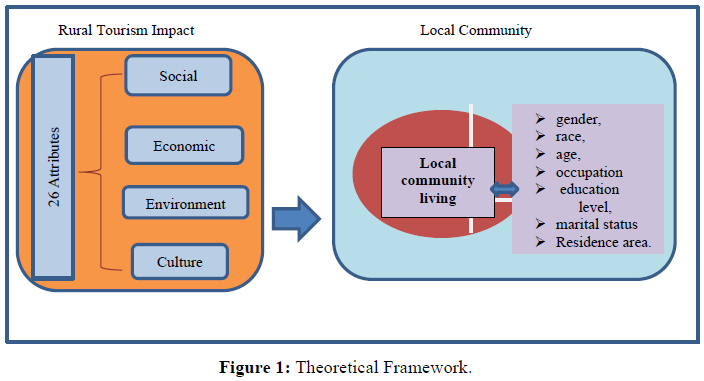
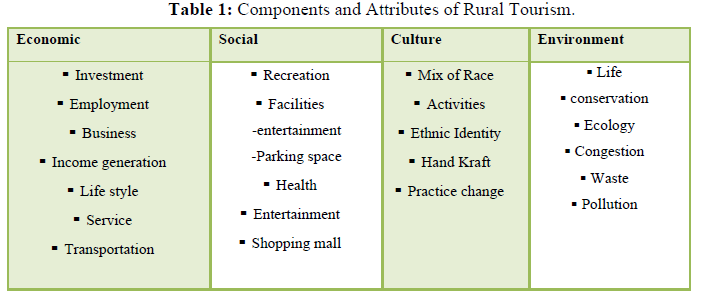
RESULTS
(Table 2) Displays the significant values of 26 elements of rural tourism impact on the study area. The research found 20 elements are significant with all demographic profiles which indicate the Asymp. Sig (2-sided) value
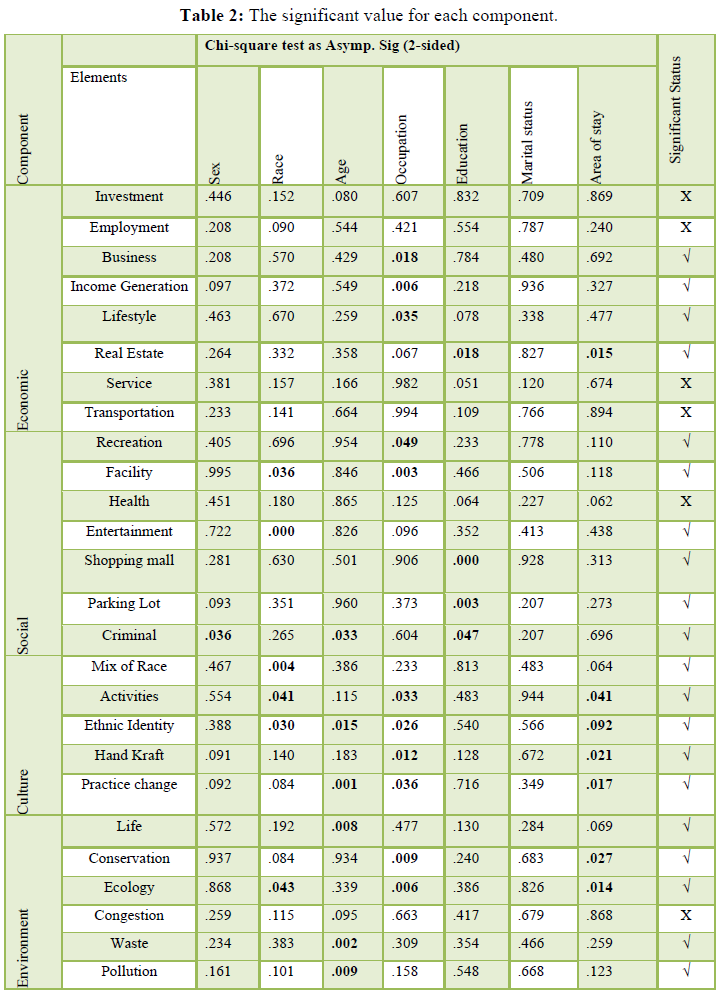
(Table 3) Displays the impact of rural tourism on the community economy that exists from two perspectives namely negative and positive. Respondents who work in the private sector stated that these tourism activities have a negative impact on their business activities (0.333) which directly affects their income (-0.384) as well as lowering their standard of living (-0.299). This is because most of the communities run small businesses which feel that the arrival of foreign traders in this rural tourist area has affected their existing business activities. On the other hand, the educated group expressed a positive effect on the economic aspect, especially the increase in property values over time (0.333).
In the social aspects, educated people agree with the existing positive effects. Rural tourism found to contribute to better social conditions with the existence of shopping malls (0.536) and parking facilities (0.413). However, according to this group, there is a crime problem in the study area. Women aged around 21-40 years consider this crime problem to be decreasing (-0.301, -0.297). Malay tribe also believes in growing entertainment activities give positive impact on community living (0.497). Meanwhile tourism activities also contribute changes in community life practices that are contrary to normal practices (-0.297). Lack of facilities was also acknowledged by the working class (-0.410). In fact, this group also expressed the poor condition of recreational facilities (-0.280).
Rural Tourism also contributes to cultural aspects within changing the identified growing community. This fact is recognized by those of the Malays (-0.308), aged between 20-40 years (-0.342) and the private sector work (-0.315). Ethnic change is becoming more pronounced due to the migration of foreigners from various races who come to the study area to expand their business. Tourism activities also contribute to the local community lifestyle which is explained by those aged between 21-50 years (-0.469), the working class (-0.297) as well as those living in other mukim areas (-0.335). Rural Tourism also affected local cultural activities (-0.302) as well as the decline in local handicraft products (-0.352), due to the greater focus on modern goods among visitors. In line with that, the sense of race among the local community towards local products as well as settlement areas is decreasing (-0.400).
Tourism activities also impacted the environment of the study area. As noted by six (6) elements in the environment, ecological changes found to be significant in the eyes of the Malay (-0.287), their career (-0.381) and those living in the rural areas of Kuala Selangor (-0.344). This group also explains that the tourism area has lacked environmental protection efforts (0.364, - 0.314). Meanwhile, those aged between 20 to 40 years old felt uncomfortable (-0.373) with the environment of the study area due to pollution activities (-0.368) from hazardous waste disposal (-0.420) in tourist areas. This is because this group involve more in tourism activities indirectly as compared to those aged 40 years and above.
Figure 2 shows the level of rural tourism impact on the local communities’ lives. In general, out of 20 significant variables, only four (4) elements contribute positive value to the local community with the highest value of 54% (availability of the shopping centre facilities) followed by 50% (entertainment facilities) which each come from the aspect social. While other elements have a negative impact with the highest record of -47% which is changing lifestyle in daily activities among the community. Apart from those problems are food waste from the hotel industry operation (-42%), and the existence of various race among the community.
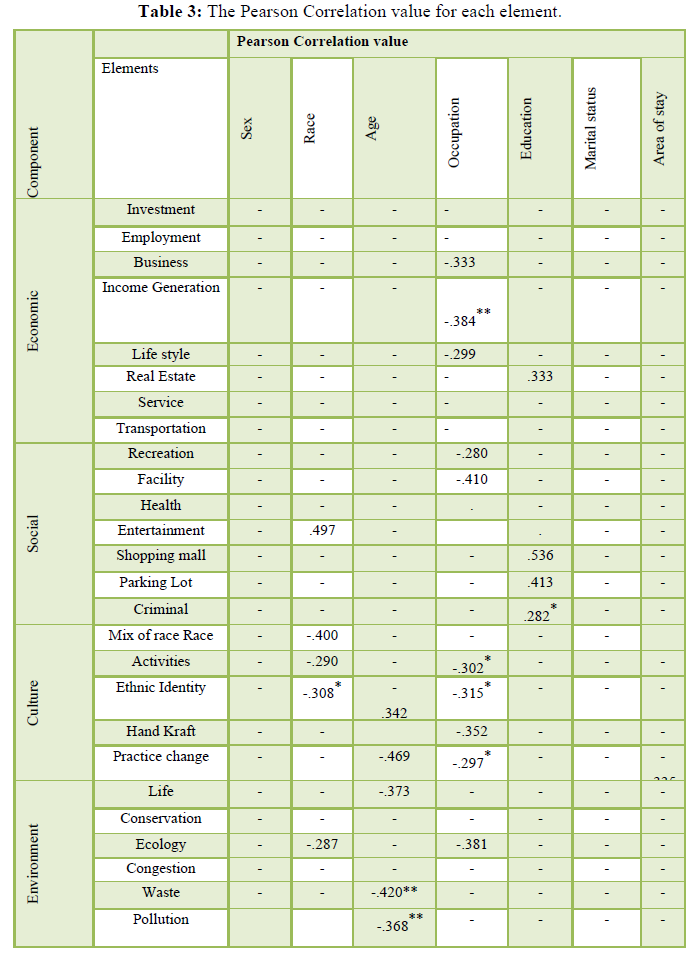
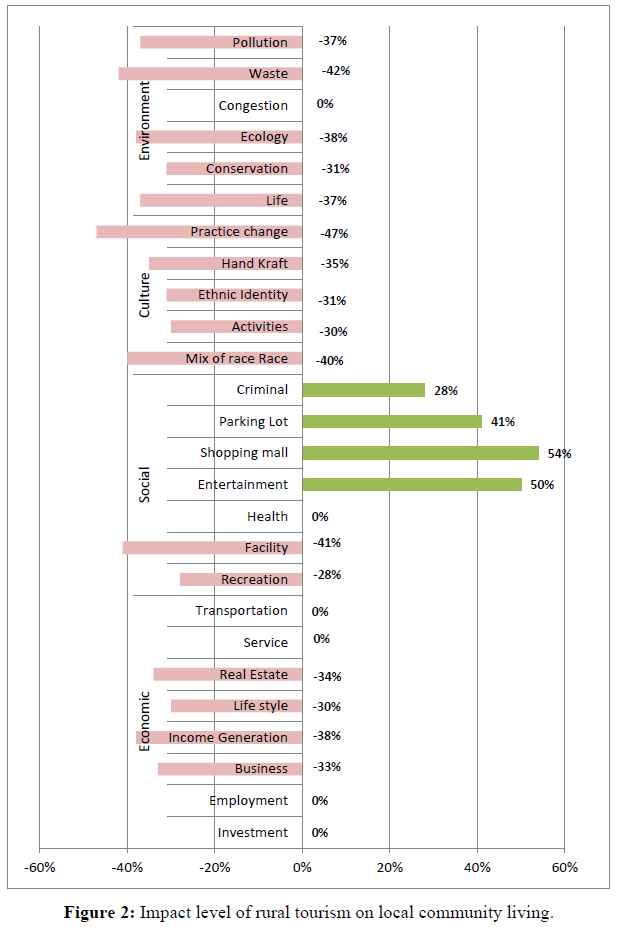
In general, rural tourism activities have a more negative impact on the local population which is 80%. Only 20% of them contribute positive value to the lives of rural communities (Figure 3).

CONCLUSION
This research explains that the vigorous rural tourism activities carried out have contributed to a significant impact on the local community’s life. From four (4) main impact components raised, the social component has experienced a more positive impact from the point of view of local people. Yet the cultural and environmental components are more vulnerable to negative effects. Rural tourism that has been going on for so long has caused the environmental conditions of tourist areas to worsen over time. While the negative impact on the culture is seen to affect the local community.
The environmental aspect should be taken into consideration by relevant authorities to ensure that every trip of tourism activity goes in line with the effort of environmental conservation. Authorities should also focus on the economic impact on the current living standards of the local community. In fact, further initiatives need to be taken to overcome this problem. This is because rural tourism activities that run without transparent monitoring are seen to benefit the people outside the district instead of the locals. Generally, the current negative impact that exists can still be monitored from time to time due to the low percentage of impact values as displayed below at a moderate level that does not exceed 50%.

CONCLUSION
This research explains that the vigorous rural tourism activities carried out have contributed to a significant impact on the local community’s life. From four (4) main impact components raised, the social component has experienced a more positive impact from the point of view of local people. Yet the cultural and environmental components are more vulnerable to negative effects. Rural tourism that has been going on for so long has caused the environmental conditions of tourist areas to worsen over time. While the negative impact on the culture is seen to affect the local community.
The environmental aspect should be taken into consideration by relevant authorities to ensure that every trip of tourism activity goes in line with the effort of environmental conservation. Authorities should also focus on the economic impact on the current living standards of the local community. In fact, further initiatives need to be taken to overcome this problem. This is because rural tourism activities that run without transparent monitoring are seen to benefit the people outside the district instead of the locals. Generally, the current negative impact that exists can still be monitored from time to time due to the low percentage of impact values as displayed below at a moderate level that does not exceed 50%.
- Alves, T.M., Kokinou, E., Ekström, M., Nikolaidis, A., Georgiou, G.C., & Miliou, A. (2021). Scientific societal and pedagogical approaches to tackle the impact of climate change on marine pollution. Scientific Reports 11(1), 2927.
- Amalu T.E., Okpara D.E., Omeje V.U., Obi P.O., & Okoruwa D.E. (2012). SocioEconomic Implication of Tourists Appraisal of The Obudu Mountain Resort Cross River State Nigeria. Journal of Environmental Science, Toxicology and Food Technology 1(3), 37-44.
Amornwitthawat, P., Phongkhieo, N.T. (2019), Proenvironmental behaviours of visitors to Thailands national parks and factors discriminating the behaviours. Asia Pacific Journal of Tourism Research, 24(10),993-1004. - Beeton, S. (2006). Community development through tourism. In Landlink Press Australia.
- Bramwell, B. (1994). Rural tourism and sustainable rural tourism. Journal of Sustainable Tourism 2(1-2), 1-6.
- Canoves, G, Villarino, M, Priestly, GK, & Blanco, A. (2004). Rural tourism in Spain An Analysis of Recent Evolution. Geoforum 35(6), 755-769.
Cheng, T.M.C. Wu, H., & Huang, L.M. (2013). The influence of place attachment on the relationship between destination attractiveness and environmentally responsible behaviour for island tourism in Penghu. Journal of Sustainable Tourism 21(8), 1166-1187. - Creaco S., & Querini G. (2003). The role of tourism in sustainable economic development, Proceeding at 43rd Congress of the European Regional Science Association. 27-30.
- Daniela, B.R., (2002). Capacity Building for Co-Management of wildlife in North America New York. Human Dimension Research Unit Department of Natural Resources Cornell University.
- Ertuna, B., & Kurbas. (2012). Local Community Involvement in Rural Tourism Development The Case of Kasstamonu Turkey. Tourism Research 10(2), 17-24.
Esfandiar, K., Dowling, R., Pearce, J., & Goh, E. (2021). What a load of rubbish the efficacy of theory of planned behaviour and norm activation model in predicting visitors binning behaviour in national parks. Journal of Hospitality and Tourism Management 46, 304-315. - Fariborz, A., & Gill S.S. (2009). Rural tourism development through Rural Cooperative Natural Science. 7(10), 68-73.
- Jaafar, M., Ismail, S., SH. S.M.R.0.L. (2015). Perceived social effect of tourism development: A case study of Kinabalu National Park. Theoretical and Empirical Research in Urban Management 10 (2), 5-20.
- Jashveer, H., Boopen, S., Kesseven, P. & Vinesh, S.R. (2011). TIPS Small Grant Scheme Research Paper Series Tourism Development and Local Community University of Mauritius Moka Mauritius.
- Jipun J. (2019). Analisis corak pembelian cenderamata di kalangan pelancong antarabangsa di Sabah. Journal of Tourism, Hospitality and Environment Management 4(15), 19-31.
- Kamil, I., & Abdoellah, O.S., (2018). Role of environmental communities in Kamojang Natural Java Natural Reservation. Journal of Tourism Hospitality and Environment Management 3(12), 46-53.
- Kim, K. (2002). The Effects of Tourism Impacts upon Quality of Life of Residents in the Community. Virginia Polytechnic Institution and State University, Blacksburg, VA.
- Kreag, G. (2001). The Impacts of Tourism Minnesota Sea Grant. University of Minnesota.
Li, Y. & Zhang, L. (2020). Research on smart rural tourism based on carbon footprint. Fresenius Environmental Bulletin 29(2), 10712-10716.
Liu, X.a, & Lu, J. (2021). Research on low-carbon tourism eco-economic system under the background of internet. Fresenius Environmental Bulletin 30(1), 802-808. - Lo, M.C., Mohamad, A.A., Songan, P. & Yeo, A.W. (2012). Positioning Rural Tourism Perspectives from the Local Communities. International Journal of Trade, Economics and Finance 3(1), 59-65.
- Mirbabayev, B. & Shagazatova, M. (2011). The Economic and Social Impact of Tourism.
- Global Journal 1(2), 25-37.
Mugilarasan, M., Karthik, R., Purvaja, R., Robin, R.S., Subbareddy, B., et.al, (2021). Spatiotemporal variations in anthropogenic marine litter pollution along the northeast beaches of India. Environmental Pollution. 280(1), 116954. - Ridzuan N.A., Ibrahim M., Mohd Razali N.A., Samengon H., Rusli S.A. (2018). Impact of Rural Tourism Products Development on Tourist Spending in Poverty Alleviation A CASE Study of Tadom Hill. Journal of Tourism, Hospitality and Environment Management 4(15), 23-28.
- Roddin R., Yusof Y., Mukhtar M.I., Hisham S.S.D.B. (2019). Kemahiran Informal komuniti orang asli suku kaum Jakun dalam bidang pelancongan. Journal of Tourism, Hospitality and Environment Management. 4(15), 44-56.
- Samina, K., Kakar, M.K., & Waliullah. (2007). Role of tourism in Economic Growth: Empirical evidence from Pakistan Economy. The Pakistan Development Review 46(4), 985-995.
- Sanggin, S.E. (2009). Community involvement in culture and nature tourism in Sarawak. AKADEMIKA 77, 149-165.
- Seetanah, B. (2011). Assessing the dynamic impact of tourism for island economies, Annals of Tourism Research, 38(1), 291-308.
- Stynes, D.J. (1997). Economic Impacts of Tourism: A handbook for tourism Professionals Illinois Bureau of Tourism Illinois Department of Commerce and Community Affairs. University of Illinois Urbana Champaign.
- Teng, T.Y., Yeap A., Yi, C.R., Shyuan, L.C., Jing, T.W., & Xin, Y.Y., (2018). Tourism Economic Growth Co Emissions the Case of Malaysia. Journal of Tourism Hospitality and Environment Management 3(12), 1-10.
- United Nation, (2005). Would population prospect. The 2004 revision volume III analytical Report United Nation New York195.
- Weaver, D., & Lawton, L. (2001). Resident Perceptions in the Urban-rural Fringe. Annals of Tourism Research 28(2), 349-458.
Yang, J., Yang, R., Chen, M.H., Su, C.H.J., Zhi, Y., & Author, Xi, J. (2021). Effects of rural revitalization on rural tourism. Journal of Hospitality and Tourism Management 47, 35-45. - Zhang, J., & Walsh, J. (2021). Tourist experience, tourist motivation and destination loyalty for historic and cultural tourists. Pertanika Journal of Social Sciences and Humanities 28(4), 3277-3296.





